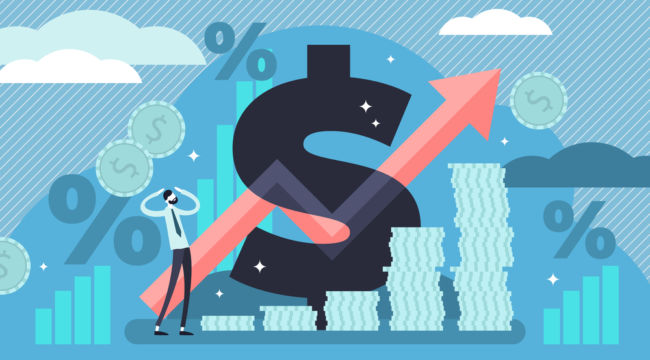Why Inflation Could Last Years
When inflation started clobbering producers and consumers last year, the general feeling in the air was: This won’t last long. After all, everyone in a position to know promised it was all transitory. Just one of those things that comes and goes before life gets back to normal.
Gradually, we’ve come to see the light. There will be no rolling back those price increases in general. There will be declines in the pace of increase here or there but overall prices have shifted upward, permanently.
That means you, me and everyone have been indirectly taxed, by about 14% over what we might have expected just two years ago.
The purchasing power of the dollar just fell faster and longer than at any point in the last 40 years. The only question now is how long this can go on and how bad it can get. Money supply increases, as measured by M2, hit a screaming high of 26% in the pace of increase on the day that Biden took office.
Measures of velocity — which indicates how quickly money changes hands and thereby has just as much influence on purchasing power — remained crashed at historic lows.
Helicopter Money
The wicked inflation hit hard, and this is because the Fed adopted a completely different strategy from the QEs of 14 years ago. Instead of locking up the counterfeit smackers in cold storage, the money was strewn throughout the streets via direct injections into bank accounts. It was a perfect act of folly or intended destruction, depending on your point of view.
M2 increases have calmed down quite a lot, rising a mere 6%, but this change has been accompanied by a shift in velocity for the first time since the summer of the first round of lockdowns.
These two forces work against each other and end up in a wash. This means that even if the Fed is truly serious about cracking down on inflation, the change in the way people are using money could mean that this could go on for years.
The real-time measures I’m seeing suggest that inflation peaked in March of this year at nearly 12% and has now fallen below 10% for the first time since January. Of course, official measures never suggested consumer prices reached those highs but the producer prices certainly did, with some sectors showing 20% increases year over year.
They’re Hoping You’ll Forget
Notice that no one in Washington is talking about an endpoint to this inflationary bout anymore. One gets the feeling that D.C. just thinks we will all eventually get used to it, same as we came around for various restrictions on liberties during the pandemic.
If at some point, the Fed and Biden can crow about inflation falling to a mere 5%, they will consider their work to be done.
They can also count on the innumeracy of the American people to help out here. Look what they did with gas prices, claiming victory because the intensity of the suffering abated for a few weeks. They rightly presume that no one has a memory longer than 30 days so we’ll forget the average price of gasoline from only two years ago.
If you fail to see the occasion for celebration here, there is a solution. Just lower your expectations! That will solve everything.
The response to the trimming of the gas prices, and the same is true of mortgages, tells you exactly where this is headed. They are working to bring about a permanent slow-go fall in the standard of living. They just hope you get used to it. Or that you are so demoralized by it all that you feel powerless to do anything about it.
Still, there remains the very serious question of just how long this inflation will last or how bad it will get. We can speculate but keep in mind that we really are dealing with a different beast today than we had in the post-2008 period of quantitative easing.
Permanent Inflation
Federal government liabilities are beyond belief at this point with the debt-to-GDP ratio running 125%, and hundreds of billions of liabilities added to the books with every act of a crazy Congress that is stealing everything not nailed to the floor.
So let’s look at the longer-term trade-off between the big numbers: money supply and consumer prices. There is nothing mechanistic or predictable about any of it. But based on what we can see from the last two years, and considering an 18-month lag in the price effects of loose money, we have every reason to expect roiling price increases for years to come.
The Short Road From Boom to Bust
The transition won’t be smooth and will continue to affect different sectors in different ways. The case of housing here is instructive. We saw a wild boom just about this time last year, in which houses in far-off rural areas were selling in a day with five bids reaching 20% above the asking price.
Lots of people were watching that mania and plotting how to get in. But then the Fed raised the discount rate, which rolled into the 30-year mortgage rate, doubling it and more over the course of 30 days. That put a very quick stop to the boom times.
The reason is apparent: Selling a house with a mortgage set to 2% is a very expensive proposition if you end up having to pick up a new mortgage at 6%. You are talking about a much less impressive piece of property, dollar for dollar. That strangled the housing boom very quickly.
It’s sad, now, to see people just now entering the seller’s market and finding that it is entirely in the hands of buyers, with owners also lowering their expectations for profits. And it all happened so quickly!
It should serve as a good reminder that there is nothing we can take for granted in this inflationary crazy economic environment, no rules of thumb that can really guide us.
My father was a thrifty man, a truly great man, but also a believer in long-term value and truth. Yes, he loved gold and silver coins too, and very much so. He accumulated them throughout his life.
As I look at that today, it is extremely obvious that this was one of his best financial decisions. He was never a day trader or a rah-rah techno champion. He clung to that which he could really trust, really own, really control.
That seems like a good way to think even now.



Comments: